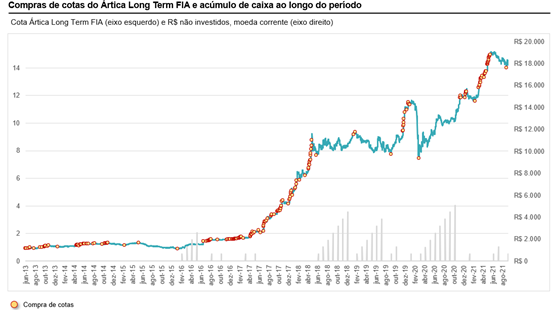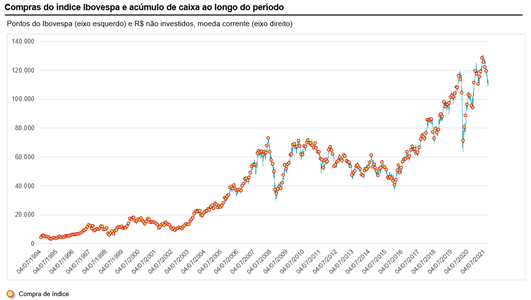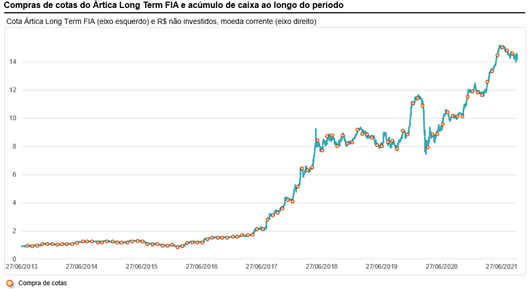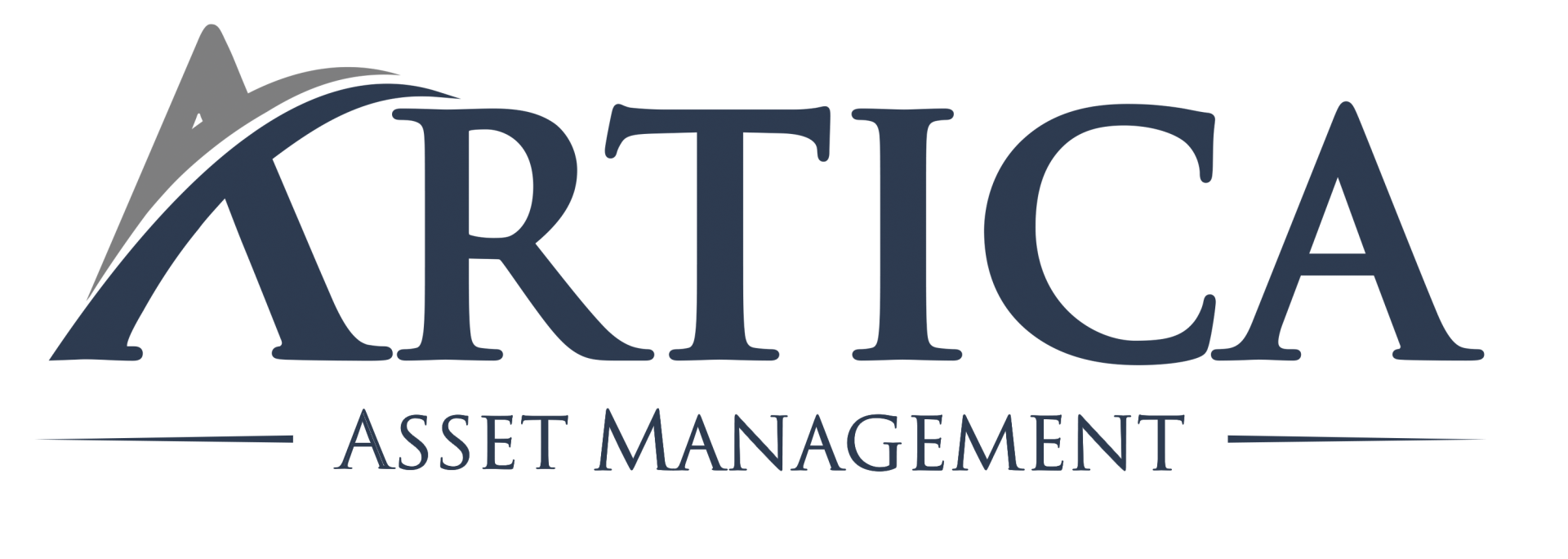Dear investors,
We are frequently asked by our shareholders: “Is now a good time to make new contributions to the fund?”. Even among us, before this study there was no consensus for this answer, and internally there were those who preferred to wait for the “ideal moment” to contribute and those who preferred to contribute smaller financial amounts more frequently.
With that in mind, we decided to simulate the return of two investment strategies on (A) Ibovespa index, since the beginning of Plano Real (July/1994), and on (B) Ártica Long Term FIA fund, since its foundation (June/2013) : the strategy (i) buy the dip, where you know exactly what the minimum point of the index is between two maximum points – and while you don't invest, the money yields 100% of the CDI – and (ii) recurring contributions, where the same contribution is made monthly.
Although we intuitively imagined that the first strategy would be much superior to the second, we were surprised to notice that the recurring contribution strategy is not far behind, even if the buy the dip assume an unrealistic situation of having perfect information and historically high interest rates in Brazil.
Methodology
To carry out this simulation, we consider an individual who every month has a thousand reais (in current currency, from 2021) available to invest. In addition, since July 1994, this individual receives a salary adjustment once a year equivalent to the IPCA for the period, also correcting his amount available to invest.
For strategy (i) buy the dip, the individual buys shares of the Ibovespa/Ártica Long Term FIA exactly at least between two trading periods all time high, that is, the lowest value between the maximum peaks. During the period in which he does not make this investment, he invests the amount in fixed income, yielding post-tax 85% of the CDI[1] until a new purchase happens. Furthermore, there are no sales of shares once purchased (buy and hold). Below, you can graphically view the purchase periods and the total cash balance (invested in CDI) available in the portfolio for simulating the Ibovespa and Ártica Long Term FIA:
[1] We are considering an income of 100% from the CDI and an Income Tax rate of 15%, resulting in 85% net of the CDI.

Graph 1.A - graphical representation of strategy purchases (i) buy the dip – Ibovespa

Graph 1.B – graphical representation of strategy purchases (i) buy the dip – Ártica Long Term FIA
As for the second strategy of recurring contributions, every first day of the month the individual buys all the money available in Ibovespa shares, regardless of the market moment. Below, you can graphically view the buying periods for the Ibovespa and Ártica Long Term FIA:

Graph 2.A - Graphical representation of strategy purchases (ii) recurring contributions – Ibovespa

Graph 2.B – Graphical representation of strategy purchases (ii) recurring contributions – Arctic Long Term FIA
Results
Using October 1, 2021 as the end of the analysis, we have the following results for different start dates:

Graph 3 – Strategies results for different start periods
Since the Real Plan, for the Ibovespa the strategy buy the dip earned a nominal annual return of 12.4%, +1.5p.p. above the recurring contribution strategy, or in other words, the recurring strategy obtained 88% of the strategy's total return buy the dip. As for the Ártica Long Term FIA, since its foundation in June 2013, the recurrent contribution strategy obtained 97% of the return of the strategy buy the dip – which earned a return of 44.6%.
Considerations and conclusion
Some considerations need to be made regarding the results obtained. The first is that it is simply impossible to consistently predict the timing perfect to carry out the contributions of the strategy buy the dip. If there was an anticipation of 30 days in the contributions, the recurring strategy would obtain 94% from the return of the strategy buy the dip for the Ibovespa, as can be seen in the chart below, where the annualized nominal returns are simulated if the contribution varied +/- days in relation to the date of dip on a constant basis for the Ibovespa and the Ártica Long Term FIA:

Graph 4 – strategy results for different errors
This result is interesting because it demonstrates, especially for the Ibovespa, that a small deviation brings profitability closer to the recurring contribution. As for the Ártica Long Term FIA, given its consistency of results, the variation is smaller, since the quota at different entry times delivered good returns.2. In this context, it is also necessary to consider that as human beings we will certainly fail in our investment discipline over the period of equity accumulation. A Mistake in Strategybuy the dip”, such as, for example, missing one or two windows for a new contribution, can impact the final return on the portfolio much more than one or two months in which we are unable to make a recurring contribution. Another consequence of this is that the tension of keeping an eye on the market trying to predict whether it has already reached the bottom apparently it doesn't make up for the expected extra return.
The second consideration is that interest rates in Brazil at the end of the 1990s and beginning of the century were structurally higher, which improved the return on money of the strategy buy the dip that was not invested. From the beginning of the Real Plan in 1994 until the end of 2010, the CDI yielded 21% pa Even with the most recent trend of rising interest rates in Brazil, the market consensus still points to an interest rate of 10.25% pa at the end of 2022, well below the historical average.
The third consideration is that if the Ibovespa had a more continuous upward trend and we excluded periods in which the stock market had strong drawdowns, the recurring contributions strategy would be even closer to the strategy buy the dip.
Within the management company, we frequently ask ourselves about the ideal strategy for investing in Ártica Long Term FIA. It is worth remembering that a significant portion of the personal assets of many of Ártica's partners and employees is invested in the fund. Among our founding partners, we have those who historically advocated for recurring contributions and those who preferred to wait for the moment of apparent greater discount to invest. We did a return analysis for both and the result was unusual: for the first, which made 51 contributions since the fund's inception, the annualized IRR is 41.4%. As for the second, which made 23 contributions seeking to be more assertive in times of lows, the annualized IRR is 40.0%.
The purpose of this letter is not to provide a definitive answer to the topic and we understand that the research is not exhaustive. But the main finding is valid: the recurring contributions strategy has a profitability close enough to the best timing possible, it does not require frantic monitoring of stock exchanges and political news and frees up space for your professional and personal development – while the compounding does its job.
²Past profitability is no guarantee of future returns.


